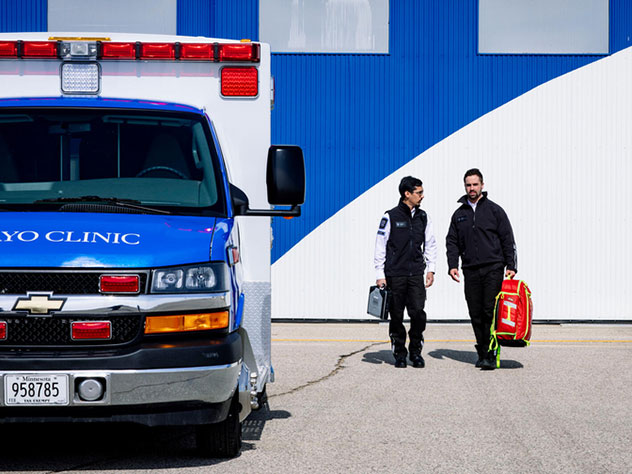July 30, 2022
When a patient experiences trauma or any medical emergency in the community, the first medical professionals they will undoubtedly encounter will be emergency medical services (EMS) providers. However, both the public and other medical professionals sometimes misunderstand these professionals.
"Sometimes people think of EMTs and paramedics more like taxicab drivers, not as medical professionals," says Aaron Klassen, M.D., M.A., an emergency medicine physician in the newly reprioritized division of EMS within the Emergency Department at Mayo Clinic's campus in Rochester, Minnesota. "They are also called ambulance drivers, often pejoratively, while this is only a tiny fraction of their jobs. Instead, these individuals are certified, credentialled, highly trained and provide medical care, all while moving the patient."
Ambulance staffing and unique skill set
Typically, two to three professionals staff an ambulance, including a paramedic, an emergency medical technician (EMT) and another staff member from one of these two professions, says Dr. Klassen, who completed an EMS-related fellowship at Regions Hospital in St. Paul, Minnesota, after finishing his medical degree.
Paramedics and EMTs often care for undifferentiated patients, such as a patient experiencing shortness of breath where it's unclear if the issue is related to the airway, heart, lungs or another factor. They are experts in providing rapid interventions while trying to determine the root of the patient's emergency condition.
"Though they technically don't make a final diagnosis, they must synthesize a large amount of incomplete data to figure out the best thing to be done for the patient," says Dr. Klassen.
EMTs and paramedics perform some advanced life support care tasks in common, but paramedics may perform more-advanced tasks and have a higher education level. These professionals may train as an EMT-basic, EMT-advanced or a paramedic.
How EMS contributes to hospital staff
EMS providers help hospital staff in numerous ways. They:
- Provide direct assistance with ground ambulance staff at a small hospital
- Offer high-level care to patients en route to the hospital in critical care transport such as the Mayo One helicopter
- Provide a report about what occurred with the patient in the field
- Update hospital staff on the patient's current status
- Serve as part of the Emergency Department and the trauma teams and as a link from the prehospital to the hospital environments
"At the end of transporting a patient, it's really less of a handoff by the EMS as it is a transition so that the patient can continue to receive high-quality care," says Dr. Klassen.
Undervaluing EMS
 Proveedores de servicios médicos de urgencia
Proveedores de servicios médicos de urgencia
Proveedores uniformados de servicios médicos de urgencia conversan junto a una ambulancia, sosteniendo sus equipos.
According to Dr. Klassen, society in general often underestimates EMS providers.
"The issue of perceiving EMS providers as merely a taxi service has been a problem endemic across the country and has led to a staffing crisis," says Dr. Klassen. "Though the problem is not due solely to the pandemic, it's become even more critical."
He indicates this is especially a challenge, as EMS training takes considerable time.
Dr. Klassen also sees varied EMS perception within hospitals. Sometimes medical professionals don't have a good understanding of what EMS providers do or the training that goes into a career as an EMT or a paramedic.
Transfer of care and EMS
Another area in which EMS may experience inadequate attention can occur at the transition of care from EMS to hospital staff. Dr Klassen says this is a potentially vulnerable time for the patient. According to an article in the April 2016 issue of Neurology: Clinical Practice, all transitions in care can be a vulnerable time for the patient. Often, in trying to do the right thing for the patient and get to work immediately assessing a patient who has experienced trauma, hospital professionals may not listen to the EMS report.
"There may be critical information to be transmitted from the EMS — even unexpected information — and this may be lost without proper attention to the report," Dr. Klassen says. "There may be information picked up by the EMS that's not necessarily visible in the chart immediately. That knowledge must be clarified to continue the excellent care from the prehospital to the hospital staff."
He urges hospital staff to seek to have good relationships with EMS providers and also to listen attentively to EMS reports and ask questions, as needed. On EMS providers' part, Dr. Klassen encourages a less-than-90-second, concise report for hospital professionals.
EMS and constructive feedback
Dr. Klassen also encourages trauma and emergency department staff to provide constructive feedback to EMS providers — even if negative, providing it's done in a respectful and professional manner. He has seen hospital staff raise their voices at EMS providers before, but he feels these communications are ineffective. As a group, he says, EMS providers are interested in gaining knowledge and in constructive feedback.
"I love EMS, because the people who choose this field are dedicated to providing great care to patients and want to continue to learn," he says.
For more information
Josephson SA. Focusing on transitions of care. Neurology: Clinical Practice. 2016;6:183.
Refer a patient to Mayo Clinic.